The Role of Interfacial Adhesion on the Mechanical Behavior of Thin Metal/Polymer Laminate with Surface Roughness
Abstract
:1. Introduction
2. Materials and Numerical Methods
2.1. Kinematics and Constitutive Law
2.2. Finite Element Model
2.3. Material Parameters Calibration
3. Comparative Results
3.1. The Influence of Surface Roughness
3.2. The Influence of Different Interfacial Properties
4. Closing Remarks
- Among three cases (roughness on Al, LDPE and both), the wavy surface on only the LDPE layer led to the most critical condition such that the maximum level of stress decreased significantly when increasing the amplitude of the wavy interface.
- The failure mode of the laminate changes by varying the imperfection location and different failure modes observed by defining surface roughness on each and both layers.
- As the existence of roughness on the surface of each layer or both in the laminate is inevitable during manufacturing, the results of this study indicate the significant influence of this type of imperfection on the functionality of thin metal/polymer laminates, which is worthwhile in real-world applications.
- At a constant separation, increasing tractions leads to higher stress and retarding the strain localization. On the other hand, at low separation, adopting higher traction results in almost the same mechanical behavior, and at high separation, the behavior of the laminate is unchanged by reducing the traction.
- Regarding the mentioned applications, these results can emphasize that adopting very high traction or very low separation does not necessarily lead to a strong interface behavior, but an optimum combination should be adopted.
Author Contributions
Funding
Institutional Review Board Statement
Informed Consent Statement
Data Availability Statement
Conflicts of Interest
References
- Shavit, D. The developments of LEDs and SMD Electronics on transparent conductive Polyester film. Vac. Int. 2007, 1, 33–35. [Google Scholar]
- Suo, Z.; Vlassak, J.; Wagner, S. Micromechanics of macroelectronics. China Particuology 2005, 3, 321–328. [Google Scholar] [CrossRef]
- Li, T.; Zhang, Z.; Michaux, B. Competing failure mechanisms of thin metal films on polymer substrates under tension. Theor. Appl. Mech. Lett. 2011, 1, 041002–041004. [Google Scholar] [CrossRef] [Green Version]
- Li, T.; Suo, Z. Ductility of thin metal films on polymer substrates modulated by interfacial adhesion. Int. J. Solids Struct. 2007, 44, 1696–1705. [Google Scholar] [CrossRef] [Green Version]
- Lu, N.; Suo, Z.; Vlassak, J.J. The effect of film thickness on the failure strain of polymer-supported metal films. Acta Mater. 2010, 58, 1679–1687. [Google Scholar] [CrossRef]
- Li, T.; Huang, Z.Y.; Xi, Z.C.; Lacour, S.P.; Wagner, S.; Suo, Z. Delocalizing strain in a thin metal film on a polymer substrate. Mech. Mater. 2005, 37, 261–273. [Google Scholar] [CrossRef]
- Xiang, Y.; Li, T.; Suo, Z.; Vlassak, J.J. High ductility of a metal film adherent on a polymer substrate. Appl. Phys. Lett. 2005, 87, 161910–161913. [Google Scholar] [CrossRef]
- Kamaliya, P.K.; Upadhyay, S.H.; Mallikarachchi, H.M.Y.C. Investigation of wrinkling behaviour in the creased thin-film laminates. Int. J. Mech. Mater. Des. 2021, 17, 899–913. [Google Scholar] [CrossRef]
- Shahmardani, M.; Ståhle, P.; Islam, M.d.S.; Kao-Walter, S. Numerical Simulation of Buckling and Post-Buckling Behavior of a Central Notched Thin Aluminum Foil with Nonlinearity in Consideration. Metals 2020, 10, 582. [Google Scholar] [CrossRef]
- Islam, M.S.; Andreasson, E.; Kao-Walter, S. Trouser tear testing of thin anisotropic polymer films and laminates. Int. J. Fract. 2019, 219, 187–201. [Google Scholar] [CrossRef] [Green Version]
- Ståhle, P.; Shahmardani, M.; Kao-Walter, S. On buckling and fracture of thin elastic-plastic foils. Procedia Struct. Integ. 2020, 28, 2065–2071. [Google Scholar] [CrossRef]
- Nowak-Grzebyta, J.; Meijer, F.; Bula, K.; Stachowska, E. Non-destructive Testing of Metal-Polymer Laminates with a Digital Holographic Vibrometer. J. Nondestruct. Eval. 2020, 39, 50. [Google Scholar] [CrossRef]
- Kao-Walter, S. On the Fracture of Thin Laminates. Ph.D. Thesis, Department of Mechanical Engineering, School of Engineering, Blekinge Institute of Technology, Karlskrona, Sweden, 2004. [Google Scholar]
- Bolzon, G.; Shahmardani, M.; Liu, R.; Zappa, E. Failure analysis of thin metal foils. Frat. Integrita Strutt. 2017, 42, 339–347. [Google Scholar] [CrossRef] [Green Version]
- Chen, S.H.; Wang, T.C.; Kao-Walter, S. A crack perpendicular to the bimaterial interface in finite solid. Int. J. Solids Struct. 2003, 40, 2731–2755. [Google Scholar] [CrossRef] [Green Version]
- Andreasson, E.; Kao-Walter, S.; Ståhle, P. Micro-mechanisms of a laminated packaging material during fracture. Eng. Fract. Mech. 2014, 127, 313–326. [Google Scholar] [CrossRef]
- Kao-Walter, S.; Dahlström, J.; Karlsson, T.; Magnusson, A. A study of the relation between the mechanical properties and the adhesion level in a laminated packaging material. Mech. Compos. Mater. 2004, 40, 29–36. [Google Scholar] [CrossRef]
- Sharif, U.; Sun, B.; Islam, M.S.; Majeed, K.; Ibrahim, D.S.; Adewale, O.O.; Akhtar, N.; Zaki, Z.I.; El-Bahy, Z.M. Fracture Toughness Analysis of Aluminum (Al) Foil and Its Adhesion with Low-Density Polyethylene (LPDE) in the Packing Industry. Coatings 2021, 11, 1079. [Google Scholar] [CrossRef]
- Andreasson, E.; Abdulfeta, J.; Katangoori, R.R. Is it possible to open beverage packages virtually? Physical tests in combination with virtual tests in Abaqus. In SIMULIA Community Conference; Providence: Rhode Island, RI, USA, 2012. [Google Scholar]
- Bolzon, G.; Shahmardani, M. Macroscopic response and decohesion models of metal-polymer laminates. Eng. Trans. 2017, 65, 53–59. [Google Scholar]
- De SouzaNeto, E.A.; Peric, D.; Owen, D.R.J. Computational Methods for Plasticity; Wiley: Torquay, UK, 2008. [Google Scholar]
- Li, B.; Li, Y.; Su, J. A combined interface element to simulate interfacial fracture of laminated shell structures. Compos. B Eng. 2014, 58, 217–227. [Google Scholar] [CrossRef]
- Xie, D.; Waas, A.M. Discrete cohesive zone model for mixed-mode fracture using finite element analysis. Eng. Fract. Mech. 2006, 73, 1783–1796. [Google Scholar] [CrossRef]
- Xu, W.; Yang, J.S.; Lu, T.J. Ductility of thin copper films on rough polymer substrates. Mater. Des. 2011, 32, 154–161. [Google Scholar] [CrossRef]
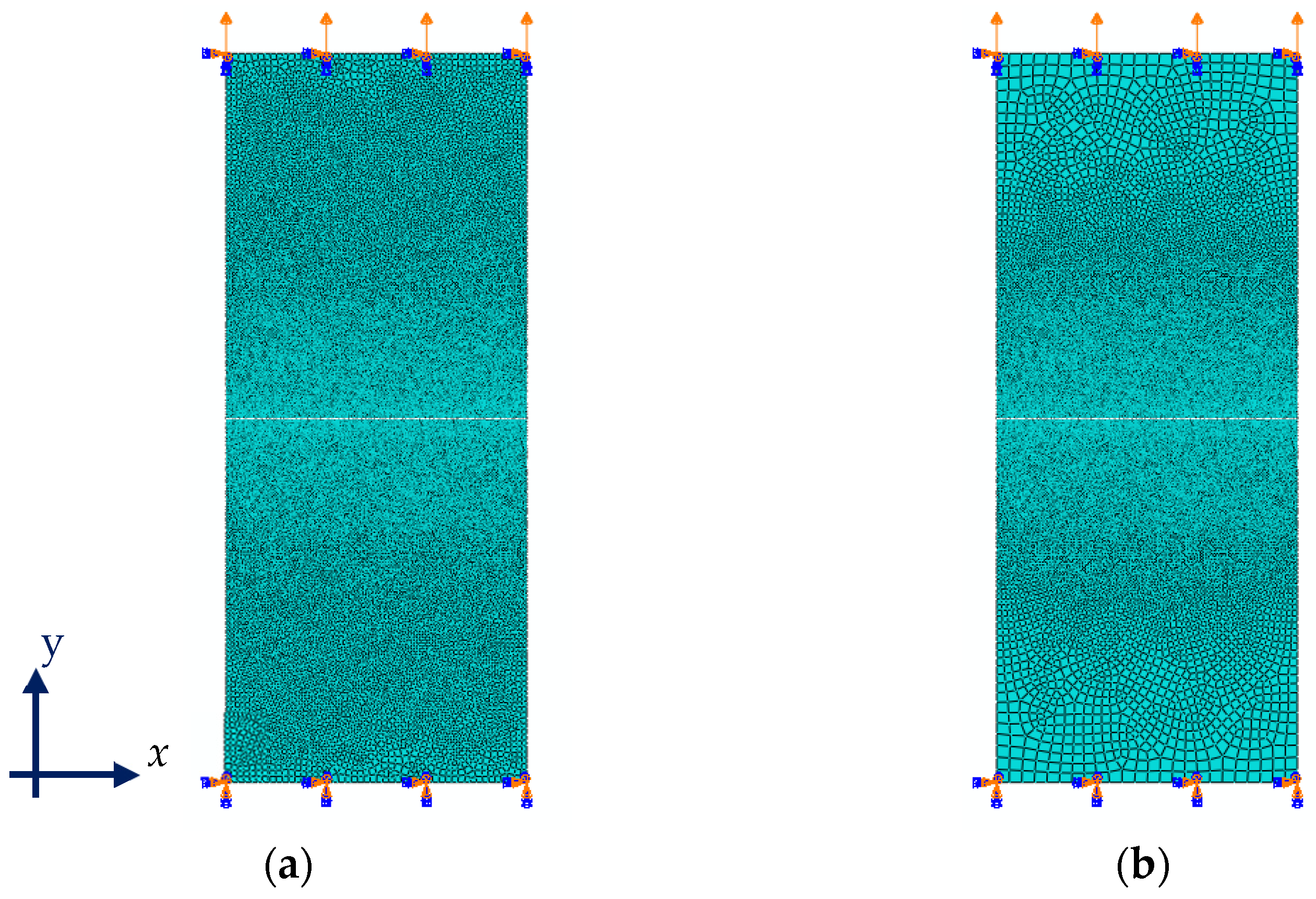

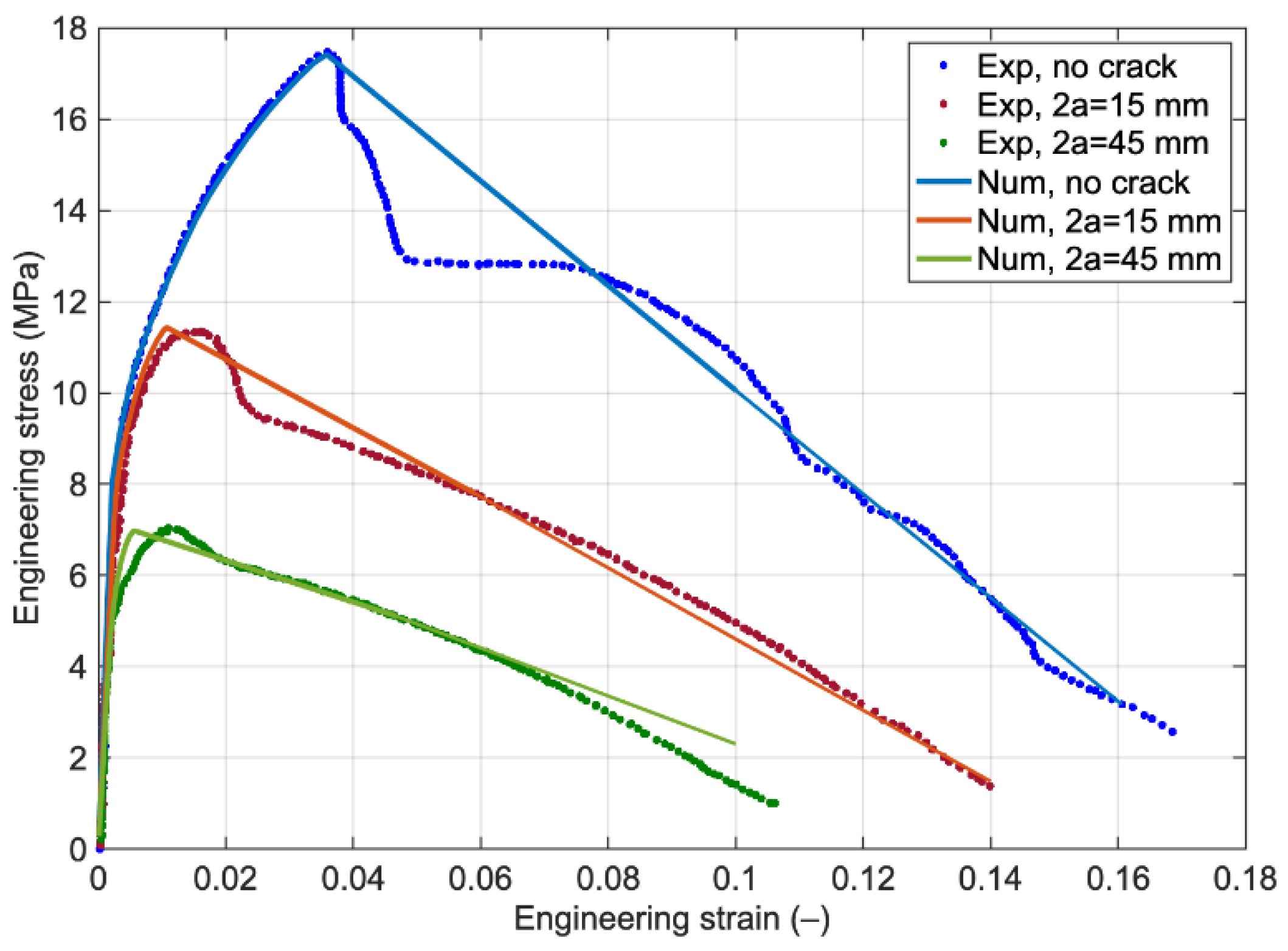
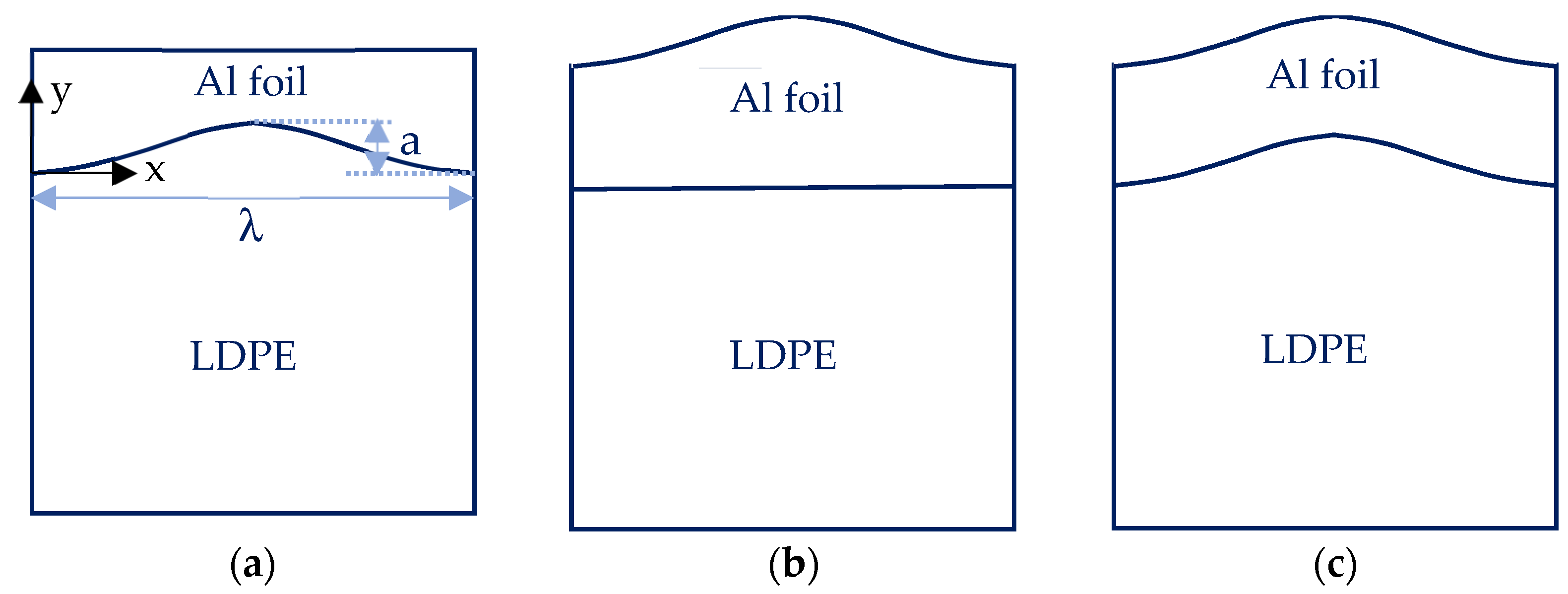

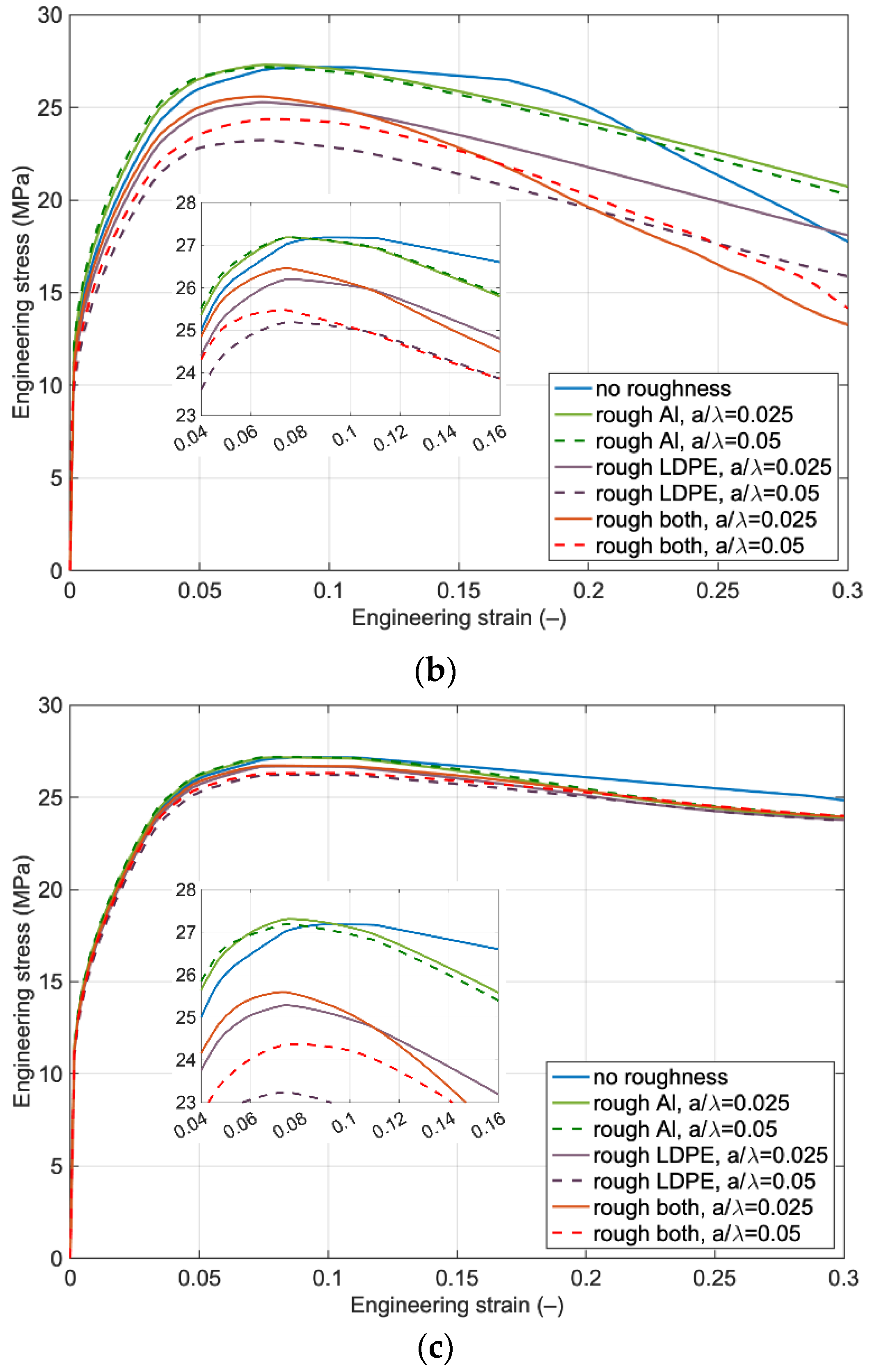
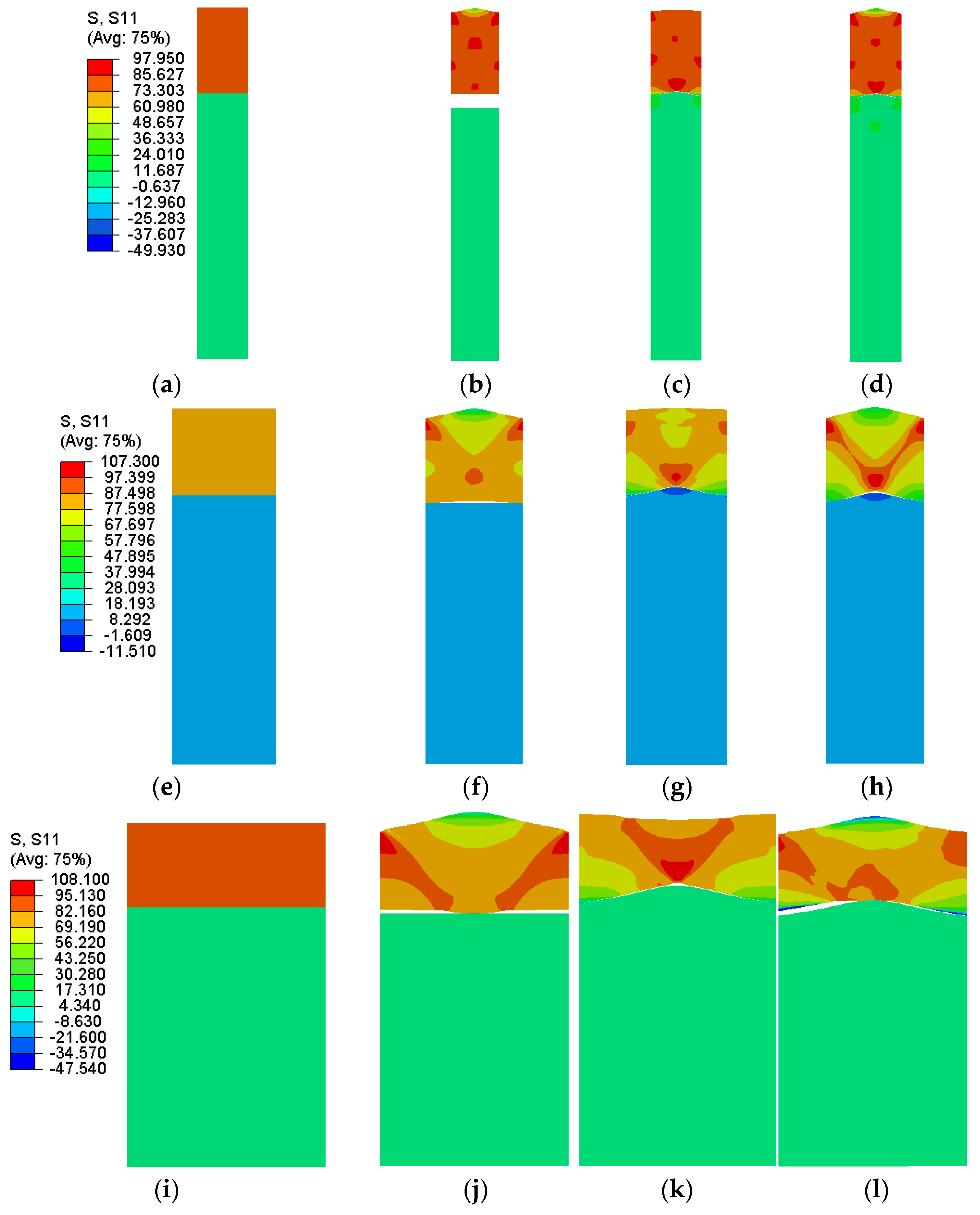
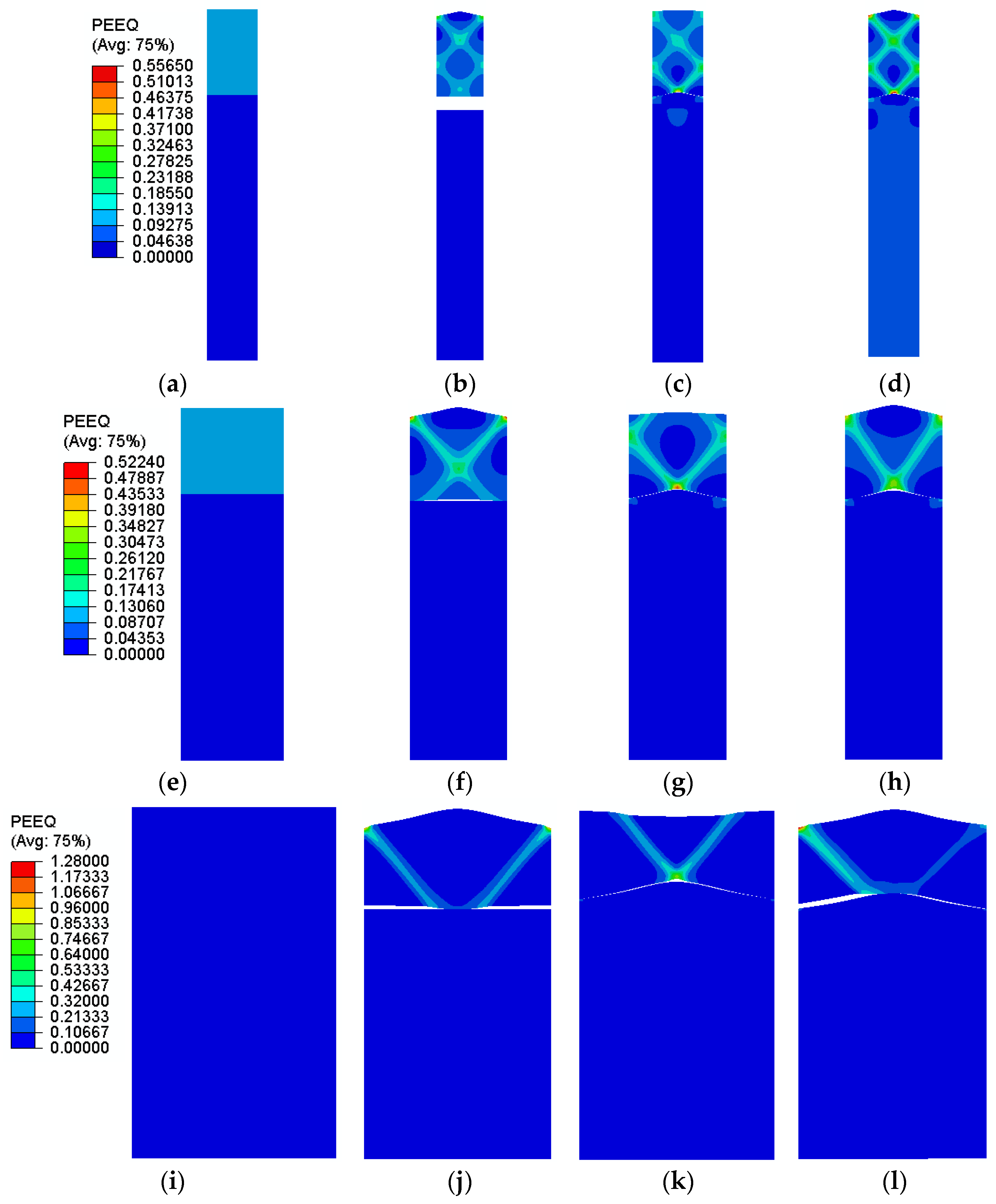

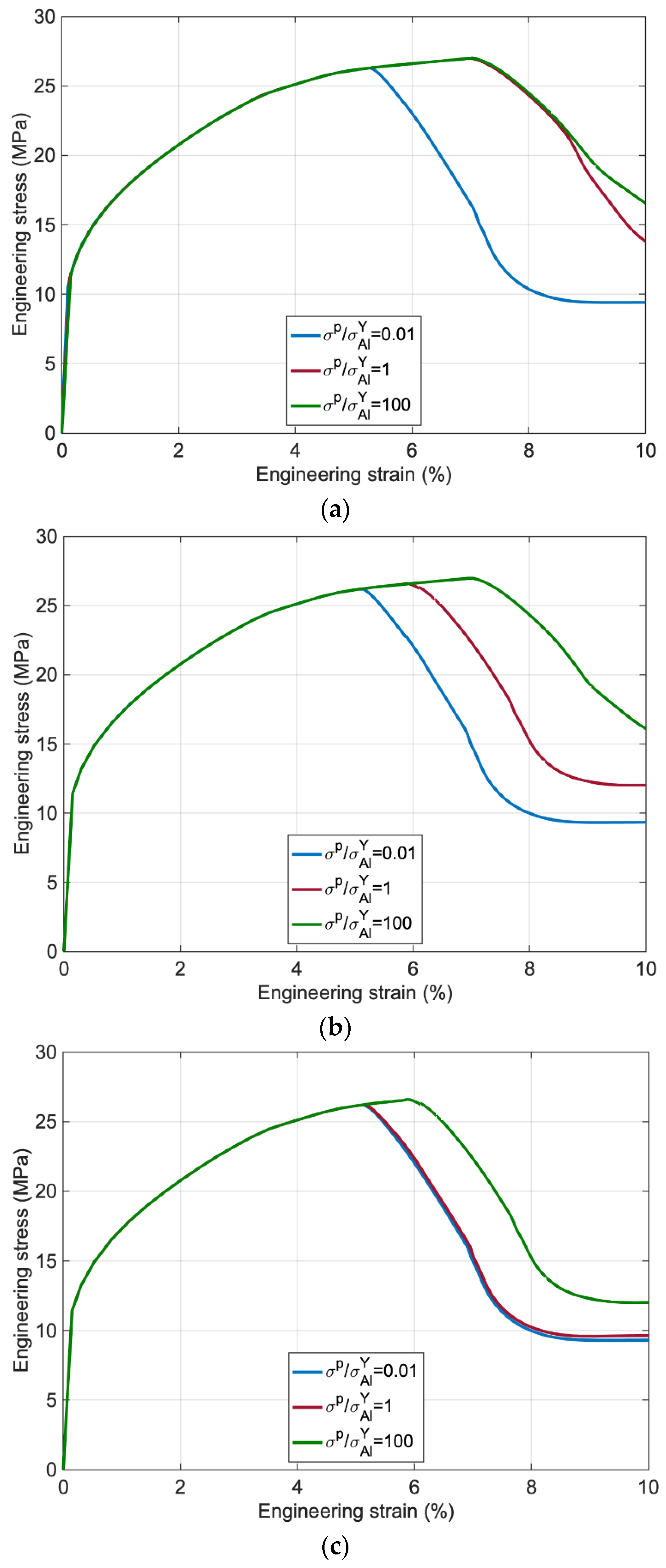
| Type | Young’s Modulus (MPa) | Poisson Ratio (−) | Yield Limit (MPa) | n (−) |
|---|---|---|---|---|
| Al foil | 46,000 | 0.3 | 35 | 0.015 |
| LDPE | 200 | 0.3 | 6.5 | 0.55 |
| Young’s Modulus (MPa) | Poisson Ratio (−) | Yield Limit (MPa) | n (−) |
|---|---|---|---|
| 17,900 | 0.3 | 8 | 0.035 |
| Length (mm) | Width (mm) | Thickness (mm) |
|---|---|---|
| 230 | 95 | 0.036 |
| Initial Stiffness (MPa/mm) | Maximum Traction (MPa) | Ultimate Separation Displacement (mm) |
|---|---|---|
| 17.9×106 | 17.5 | 36 |
| Maximum Traction Ratio (−) | Separation Ratio (−) |
|---|---|
| 0.01 | 0.01 |
| 1 | 1 |
| 100 | 100 |
Publisher’s Note: MDPI stays neutral with regard to jurisdictional claims in published maps and institutional affiliations. |
© 2022 by the authors. Licensee MDPI, Basel, Switzerland. This article is an open access article distributed under the terms and conditions of the Creative Commons Attribution (CC BY) license (https://creativecommons.org/licenses/by/4.0/).
Share and Cite
Shahmardani, M.; Mohammadi, R. The Role of Interfacial Adhesion on the Mechanical Behavior of Thin Metal/Polymer Laminate with Surface Roughness. Polymers 2022, 14, 3131. https://doi.org/10.3390/polym14153131
Shahmardani M, Mohammadi R. The Role of Interfacial Adhesion on the Mechanical Behavior of Thin Metal/Polymer Laminate with Surface Roughness. Polymers. 2022; 14(15):3131. https://doi.org/10.3390/polym14153131
Chicago/Turabian StyleShahmardani, Mahdieh, and Rafat Mohammadi. 2022. "The Role of Interfacial Adhesion on the Mechanical Behavior of Thin Metal/Polymer Laminate with Surface Roughness" Polymers 14, no. 15: 3131. https://doi.org/10.3390/polym14153131






